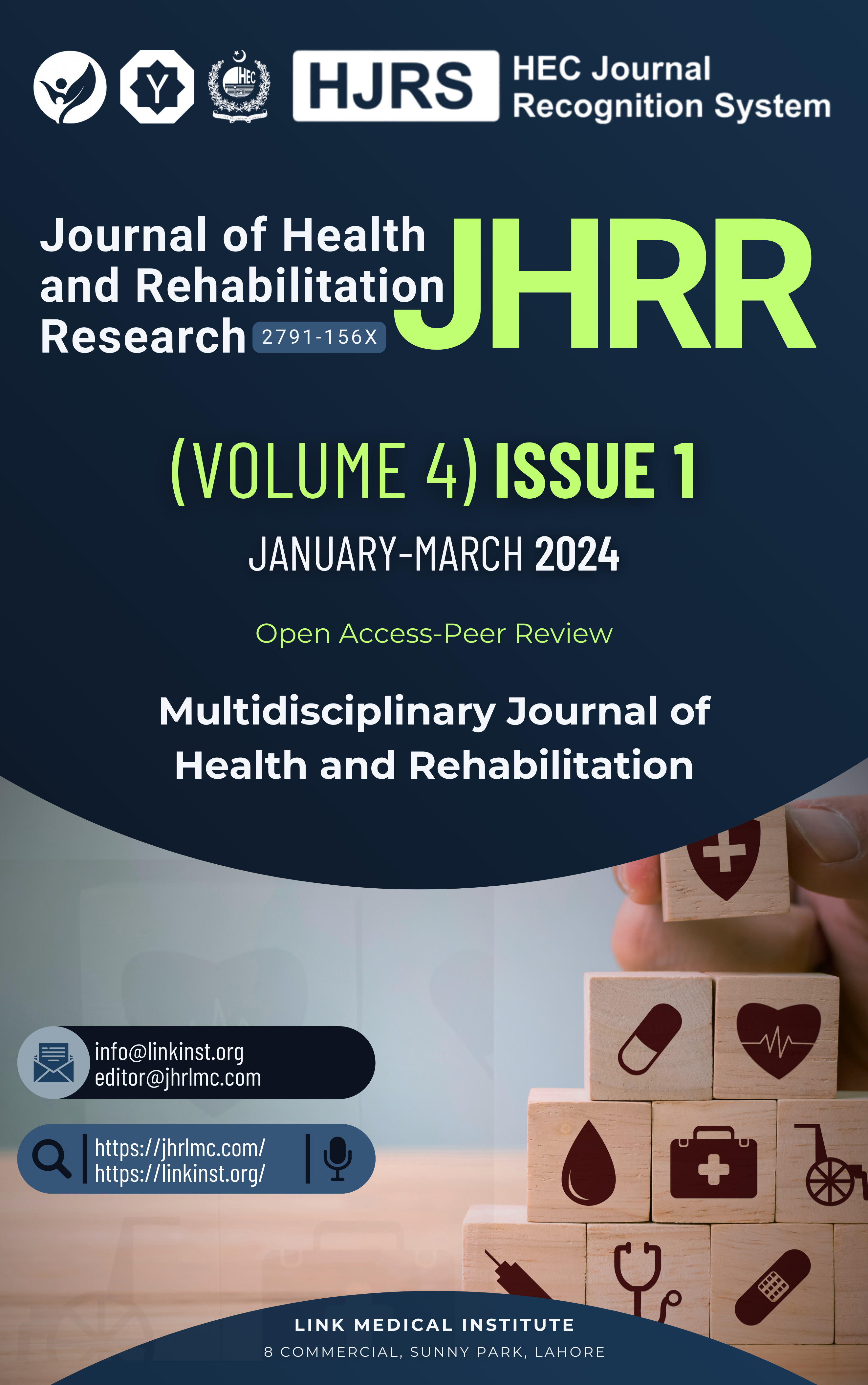Effect of Working Length Determination Using X-Ray and Apex Locator on Postoperative Pain
DOI:
https://doi.org/10.61919/jhrr.v4i1.1767Keywords:
Working Length, Postoperative Pain, Electronic Apex Locator, Periapical Radiographs, Root Canal Treatment, Endodontic Pain Management.Abstract
Background: Accurate determination of working length is crucial for successful root canal treatment, with periapical radiographs and electronic apex locators being the primary methods. While both techniques are widely used, their comparative impact on postoperative pain remains inconclusive.
Objective: This study aimed to evaluate the effect of working length determination using periapical radiographs and electronic apex locators on postoperative pain intensity and resolution in patients undergoing root canal treatment.
Methods: A randomized controlled trial (n = 110) was conducted on systemically healthy patients requiring root canal treatment for single-rooted teeth. Patients were randomly assigned to either the radiographic or apex locator group. Standardized chemomechanical preparation was performed using ProTaper rotary files, and pain intensity was assessed at multiple intervals (4, 6, 12, 24, and 48 hours) using a validated 4-point pain scale. Statistical analysis was performed using SPSS v27, with chi-square, Mann–Whitney U, and Friedman tests applied (P < 0.05). Ethical approval was granted.
Results: No statistically significant difference in postoperative pain was observed between groups at any time point (P > 0.05). The mean pain resolution time was 3.37 ± 2.79 days for the radiographic group and 2.79 ± 3.34 days for the apex locator group (P > 0.05). Clinically, both methods were equally effective in managing pain.
Conclusion: Working length determination using periapical radiographs or electronic apex locators does not significantly impact postoperative pain. Given their comparable efficacy, apex locators may be preferred due to reduced radiation exposure. Further research should explore outcomes in multi-rooted teeth and necrotic pulp cases.
Downloads
References
American Association of Endodontists. Glossary of Endodontic Terms. 8th ed. Chicago: American Association of Endodontists; 2012.
Ricucci D, Langeland K. Apical Limit of Root Canal Instrumentation and Obturation, Part 2: A Histological Study. Int Endod J. 1998;31(6):394-409. doi:10.1046/j.1365-2591.1998.00176.x
Mancini M, Felici R, Conte G, Costanza A, Cianconi L. Accuracy of Three Electronic Apex Locators in Anterior and Posterior Teeth: An Ex Vivo Study. J Endod. 2011;37(5):684-7. doi:10.1016/j.joen.2011.01.011
Jeger FB, Janner SF, Bornstein MM, Lussi A. Endodontic Working Length Measurement with Preexisting Cone-Beam Computed Tomography Scanning: A Prospective, Controlled Clinical Study. J Endod. 2012;38(7):884-8. doi:10.1016/j.joen.2012.03.005
Ravanshad S, Adl A, Anvar J. Effect of Working Length Measurement by Electronic Apex Locator or Radiography on the Adequacy of Final Working Length: A Randomized Clinical Trial. J Endod. 2010;36(10):1753-6. doi:10.1016/j.joen.2010.07.011
Sathorn C, Parashos P, Messer H. The Prevalence of Postoperative Pain and Flare-Up in Single- and Multiple-Visit Endodontic Treatment: A Systematic Review. Int Endod J. 2008;41(2):91-9. doi:10.1111/j.1365-2591.2007.01316.x
Seltzer S. Pain in Endodontics. J Endod. 1986;12(10):505-8. doi:10.1016/S0099-2399(86)80253-6
Sjogren U, Hagglund B, Sundqvist G, Wing K. Factors Affecting the Long-Term Results of Endodontic Treatment. J Endod. 1990;16(10):498-504. doi:10.1016/S0099-2399(07)80180-4
Jalalzadeh SM, Mamavi A, Shahriari S, Gholami L, Bolhari B. Effect of Pretreatment Prednisolone on Postendodontic Pain: A Double-Blind Parallel-Randomized Clinical Trial. J Endod. 2010;36(6):978-81. doi:10.1016/j.joen.2010.02.005
de Camargo EJ, Zapata RO, Medeiros PL, Bramante CM, Bernardineli N, Garcia RB, et al. Influence of Preflaring on the Accuracy of Length Determination with Four Electronic Apex Locators. J Endod. 2009;35(9):1300-2. doi:10.1016/j.joen.2009.06.003
Contreras MA, Zinman EH, Kaplan SK. Comparison of the First File That Fits at the Apex, Before and After Early Flaring. J Endod. 2001;27(2):113-6. doi:10.1097/00004770-200102000-00014
Grossman LI, Oliet S, Del Rio CE. Preparation of the Root Canal: Equipment and Technique for Cleaning, Shaping, and Irrigation. In: Grossman LE, Oliet S, Del Rio CE, editors. Endodontic Practice. 11th ed. Philadelphia: Lea & Febiger; 1988. p. 179-227.
Mickel AK, Chogle S, Liddle J, Huffaker K, Jones JJ. The Role of Apical Size Determination and Enlargement in the Reduction of Intracanal Bacteria. J Endod. 2007;33(1):21-3. doi:10.1016/j.joen.2006.09.006
Stabholz A, Rotstein I, Torabinejad M. Effect of Preflaring on Tactile Detection of the Apical Constriction. J Endod. 1995;21(2):92-4. doi:10.1016/S0099-2399(06)80430-4
Torabinejad M, Kettering JD, McGraw JC, Cummings RR, Dwyer TG. Factors Associated with Endodontic Interappointment Emergencies of Teeth with Necrotic Pulps. J Endod. 1988;14(5):261-6. doi:10.1016/S0099-2399(88)80134-6
Kuttler Y. Microscopic Investigation of Root Apexes. J Am Dent Assoc. 1955;50(5):544-52. doi:10.14219/jada.archive.1955.0095
Tselnik M, Baumgartner JC, Marshall JG. An Evaluation of Root ZX and Elements Diagnostic Apex Locators. J Endod. 2005;31(7):507-9. doi:10.1097/01.don.0000157992.82079.0a
Plotino G, Grande NM, Brigante L, Lesti M, Somma F. Ex Vivo Accuracy of Three Electronic Apex Locators: Root ZX, Elements Diagnostic Unit and Apex Locator, and ProPex. Int Endod J. 2006;39(5):408-14. doi:10.1111/j.1365-2591.2006.01095.x
Alonso-Ezpeleta LO, Gasco-Garcia C, Castellanos-Cosano L, Martin-Gonzalez J, Lopez-Frigard A, Segura-Egea JJ. Postoperative Pain After One-Visit Root-Canal Treatment on Teeth with Vital Pulps: Comparison of Three Different Obturation Techniques. Med Oral Patol Oral Cir Bucal. 2012;17(4):e721-7. doi:10.4317/medoral.17692
Pak JG, White SN. Pain Prevalence and Severity Before, During, and After Root Canal Treatment: A Systematic Review. J Endod. 2011;37(4):429-38. doi:10.1016/j.joen.2010.12.016
Downloads
Published
How to Cite
Issue
Section
License
Copyright (c) 2024 Farhat Fatima, Syed Atta Ullah Shah, Sangeen Ameer, Shazmeen Alim, Sadia Malik, Sadia Khaliq

This work is licensed under a Creative Commons Attribution 4.0 International License.
Public Licensing Terms
This work is licensed under the Creative Commons Attribution 4.0 International License (CC BY 4.0). Under this license:
- You are free to share (copy and redistribute the material in any medium or format) and adapt (remix, transform, and build upon the material) for any purpose, including commercial use.
- Attribution must be given to the original author(s) and source in a manner that is reasonable and does not imply endorsement.
- No additional restrictions may be applied that conflict with the terms of this license.
For more details, visit: https://creativecommons.org/licenses/by/4.0/.






